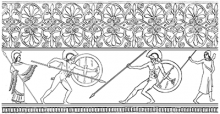
You are here
Episode 9: The Anger of Achilles
Story summary
Teaching activities
- Starting points
- Follow-up
- Further activities
- Discuss Achilles’ reaction to the death of Patroclus, and how Odysseus had reacted to Achilles. What would or could learners have done if they had been there to help Achilles?
-
Ask learners to read any obituaries or poems written after hearing the last episode. This activity would benefit from being prepared before the session, so that the readings are clear and confident.
-
Remind the class that Achilles’ armour will not protect him from his fate.
-
Warn the class that the fight is about to happen. This part of the story is very powerful and learners may react as events unfold in their imaginations! If this does happen it is an interesting point to discuss.
If you have not used the pause points it is advisable to discuss the death of Hector straight away and then go back to talk about other aspects of this episode. Learners may be shocked by the callous and brutal behaviour of Achilles. Remind them that they have heard about this before. Where? (When he was waiting to fight and was sent away by Agamemnon. Andromache also speaks about the murder of her family by Achilles. The Trojans are terrified of him and even his own king, Agamemnon, called him a monster.)
-
Use the learners’ reaction to stimulate research on Ancient Greek battle tactics and weapons. (Fighting in the Homeric era involved a series of individual duels whereas by the fifth century BC, warriors fought much more as organised armies.) As a starting point they may wish to contrast the picture of Achilles and Hector with the illustration
![[pdf] [pdf]](/sites/default/files/pdf_icon.png) General battle scene (Episode 4). Does this battle sound convincing and based on real-life events? What is their evidence for their answers?
General battle scene (Episode 4). Does this battle sound convincing and based on real-life events? What is their evidence for their answers? -
Look again at the preparations for Patroclus’ funeral. Investigate the funeral rituals of the ancient Greeks and, using the research, write an eyewitness account of it. You can display and /or read these in conjunction with the obituaries of Patroclus.
-
Ask learners to imagine how Achilles feels as he puts on his new armour. Describe those thoughts and feelings. Alternatively, write a letter or a diary entry from Achilles to Patroclus.
-
Replay the duel between Achilles and Hector ("Hector's fate in the balance ") and ask the class to listen carefully and/or take notes in preparation for a detailed retelling.
-
Can they predict what will happen now that Hector is dead?
-
What are the names of the four horses of Achilles? (Lightfoot, Dapple, Dancer, Beauty.)
-
What did Achilles say to them? Why? (“This time bring your master home.” Patroclus did not come safely back with them.)
-
Explain what Beauty’s response means. (She tells Achilles that it was the will of the gods that caused Patroclus’ death, not any negligence on their part. They too are at the mercy of the gods.)
Discuss the actions of Thetis throughout the story. Should she have intervened? Why does she go on supporting Achilles? Should a mother support her son even when she knows that he is wrong?
Visual aids
Achilles and Hector
Based on a vase by the Berlin Painter, 490-480 BC. British Museum, London.
This picture captures the moment when Hector is deserted by the gods. The figure on the right is Apollo, turning his back on Hector with a final look over his shoulder. Meanwhile Achilles, urged on by Athene (on the far left), presses home his advantage. The angle of the fighters’ spears emphasises Achilles’ forward movement and Hector’s backward stumble.

Hector desecrated
Based on a vase by the Leagros Group, c. 510-500 BC. Delos Museum.
In this scene the painter has merged two elements of Homer’s story, Achilles’ lament at the tomb of Patroclus (shown as a mound on the extreme right) and his desecration of Hector’s body which he attaches to his chariot and drags round the walls of Troy. Between Achilles and the tomb floats the winged soul of Patroclus (Hector’s can be seen on the far left). At Achilles’ feet lies the body of Hector, face up here rather than face down as in Homer’s Iliad.
